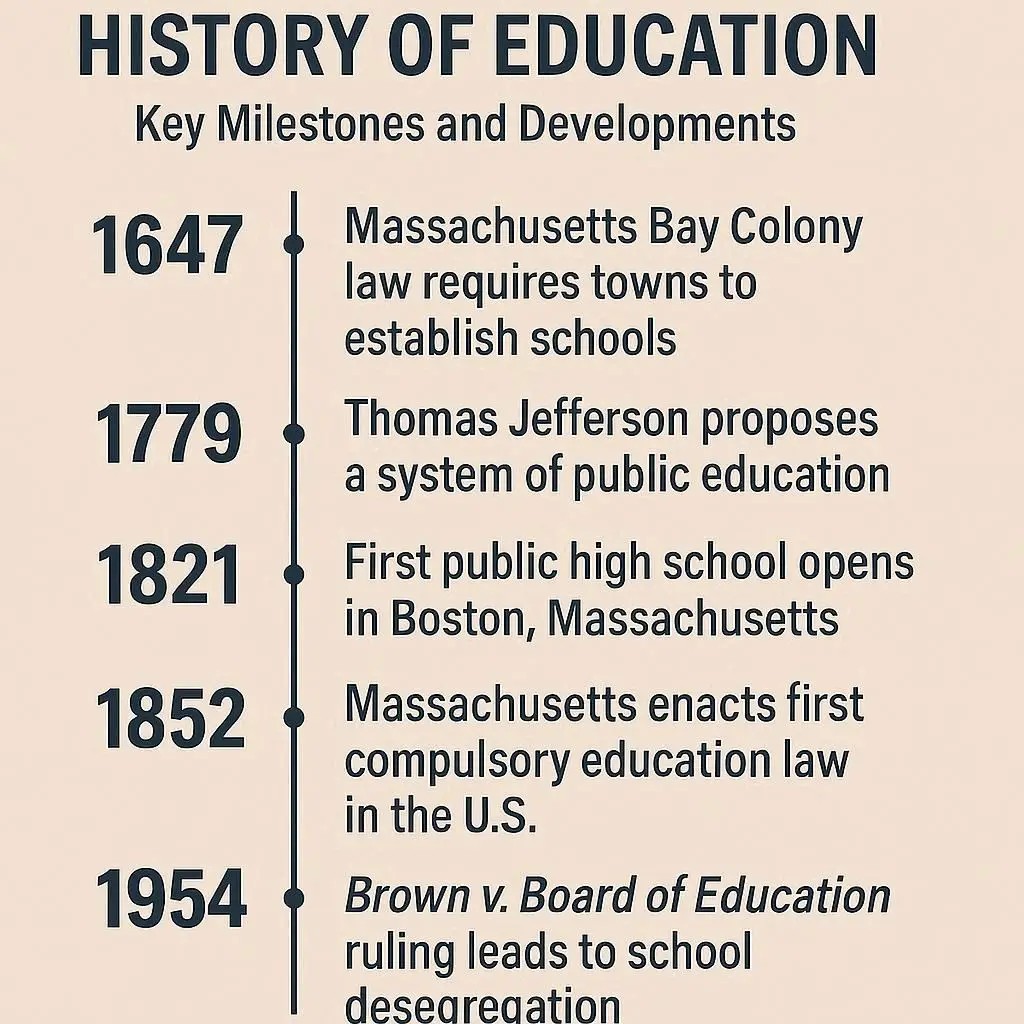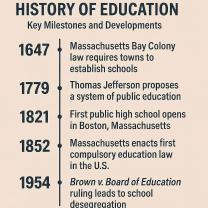What is the history of Education in America?
An interactive journey through key milestones and developments.
Colonial Foundations (1600s-1700s)
In the colonial period, education was highly localized and primarily driven by religious motives. The main goal was to ensure colonists could read the Bible. There was no standardized system; education varied significantly by region, with New England Puritans being early proponents of public schooling laws. This section explores the origins of American education, from dame schools to the founding of the first universities.
Key Developments
- 1635: Boston Latin School, the first public school in America, is established.
- 1636: Harvard College is founded, the first institution of higher education.
- 1647: The Massachusetts "Old Deluder Satan Act" is passed, requiring towns to establish and maintain schools.
- Education focused on religion, reading, writing, and arithmetic.
- Access was largely limited to white males, particularly from wealthier families.
Growth of Higher Education
Number of colleges founded by era.
The Common School Era (1820s-1880s)
The 19th century saw a revolutionary shift with the rise of the Common School Movement. Led by reformers like Horace Mann, this movement advocated for free, tax-supported public schools for all children, regardless of background. The goal was to create a common civic culture, assimilate immigrants, and provide citizens with the knowledge needed for a democracy. This era laid the groundwork for the comprehensive public school system we know today.
Key Developments
- Horace Mann becomes Secretary of the Massachusetts Board of Education in 1837, championing standardization.
- Establishment of "normal schools" for teacher training.
- McGuffey Readers become standardized textbooks, teaching morality and patriotism.
- Public education expands rapidly, especially in Northern states.
Rising Literacy Rates
U.S. literacy rate for the total population.
Expansion & Segregation (1880s-1950s)
From the late 19th to the mid-20th century, American education experienced both massive growth and deep-seated inequality. The Progressive Era brought new ideas about child-centered learning from thinkers like John Dewey. High school enrollment soared, and land-grant colleges expanded access to higher education. However, this progress was marred by the "separate but equal" doctrine, which institutionalized racial segregation and unequal funding in schools across the country.
Key Developments
- John Dewey's progressive education philosophy emphasizes learning by doing.
- 1862: The Morrill Land-Grant Act funds colleges specializing in agriculture and mechanical arts.
- 1896: The Supreme Court's ruling in Plessy v. Ferguson upholds racial segregation in public facilities, including schools.
- High school attendance becomes more common for adolescents.
Landmark Legislation
Click an item to learn more.
Select an act to see its description.Federal Era & Modern Reforms (1950s-Present)
The post-WWII era marked a dramatic increase in federal involvement in education, driven by the Cold War, the Civil Rights Movement, and a growing concern for equity and standards. Landmark court cases and legislation desegregated schools and aimed to close achievement gaps. Recent decades have been characterized by debates over standardized testing, accountability, charter schools, and the role of technology in the classroom, reflecting a continued push to define and achieve excellence in American education.
Key Developments
- 1954: Brown v. Board of Education declares state-sponsored school segregation unconstitutional.
- 1965: The Elementary and Secondary Education Act (ESEA) provides significant federal funding to schools.
- 1972: Title IX prohibits sex-based discrimination in federally funded education programs.
- 2002: No Child Left Behind Act increases accountability and standardized testing.
Landmark Legislation
Click an item to learn more.
Select an act to see its description.










